News
In 1891 the new Philharmonic Society building was opened in the lower part of the Congress Square in Ljubljana.
The building, designed by Wilhelm Trea, was built in the place of an old theatre, which had burnt down several years earlier.
The opening ceremony of the Philharmonic Society’s “own house, the asylum of the musical art, the decoration of the city and the witness of the citizens’ refined artistic sense” was accompanied by large celebrations, with artists from all sides joining the orchestra, which numbered more than eighty members, and the choir consisting of more than a hundred opera singers. They played Wagner, Beethoven and Liszt, while there was no shortage of ceremonial speeches as well.
All the important people of Ljubljana were there, and so was the provincial chief Andrej Baron Winkler, who in the name of the Emperor Franz Joseph I solemnly decorated the Philharmonic Society with a golden medal.
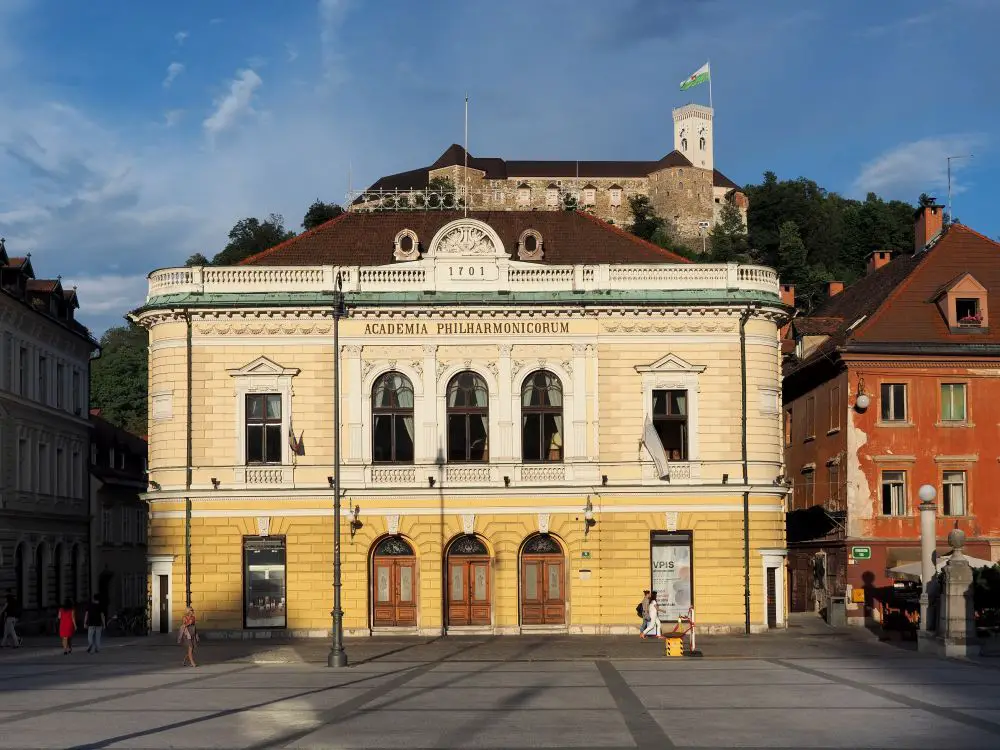
Visitors to Congress Square will see 1701 on the front of the Philharmonic building, but this refers to the year in which the Music Academy was established. The building itself replaced the Provincial Theatre, which burned down in 1887, as shown in the painting below.
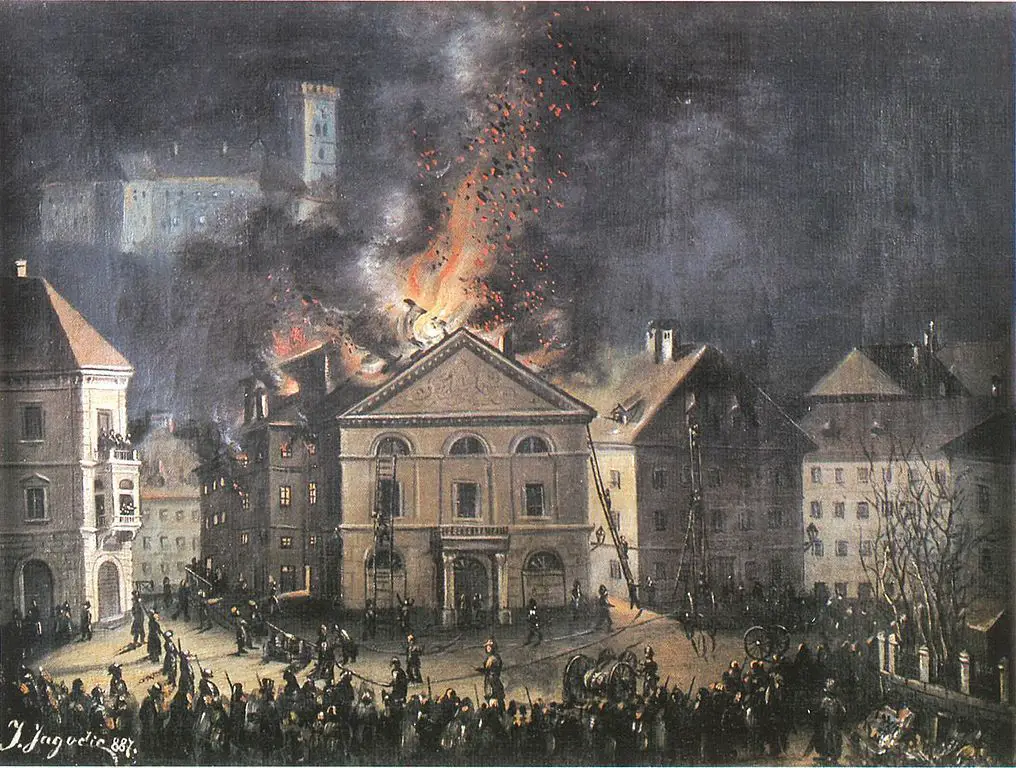
STA, 24 October 2019 - Slovenian police have busted a ring that made an estimated EUR 1.3 million in illegal gain by smuggling Chinese nationals to Italy through Slovenia. Of the four Slovenians and eight Chinese operating the ring, three are in detention and two in house arrest, Maribor police said on Thursday.
One of the detained suspects is a Slovenian citizen and the others are Chinese with permanent residence in Slovenia.
The members of the ring are suspected of helping at least 143 Chinese enter Slovenia illegally through Serbia, Bosnia and Croatia over the past year and a half, Maribor's criminal police chief Beno Meglič said at today's news conference.
To get illegally from China to Italy, a Chinese citizen had to pay from EUR 9,000 to EUR 14,000, the police officer said.
The smuggled persons had been lured to Italy in China and transported to Europe, chiefly Moscow, by plane.
The route then ran to Serbia's Belgrade, from where they were taken on to Croatia or to Bosnia, and from there to Slovenia, Italy's eastern neighbour.
The Chinese entered Slovenia in the north-east of the country, in the area near the city of Ptuj.
Taxi services were used to transport them from Ptuj to the Italian border or to Italy, with four of the suspects posing as taxi drivers.
As many as five of Slovenia's eight police departments took part in the investigation, which lasted a year and a half and ended on 16 October.
The police also seized some EUR 39,000 in cash, passports and several electronic devices.
Under the Slovenian penal code, the crime of smuggling people illegally across the state border carries a prison sentence of one to eight years, and a fine.
STA, 24 October 2019 - After three years of steep growth, real estate prices started to show signs of stagnation in the first half of 2019. Prices of flats are very close to the record figures seen in 2008, while prices of houses are lagging behind significantly, show data from the Mapping and Surveying Authority.
The average price for a second-hand flat in Slovenia in the first half of 2019 was EUR 1,810 per square metre, which was 1.7% more than in the second half of 2018.
Prices of flats have been growing fast since 2015, when a downward trend finally reverted after the 2008 economic and financial crisis.
Alone in the first half of 2018 the average price for a second-hand apartment increased by nearly 7%, the Mapping and Surveying Authority noted on Thursday.
But the second half of 2018 and the first half of 2019 saw the growth in prices slowing down to 2%, above all due to stagnation of prices in Ljubljana.
The average price for a second-hand apartment in Ljubljana was at EUR 2,780 per square metre between January and June, which was about 0.5% more than in the second half of 2018. The authority says that prices have stagnated in Ljubljana since the beginning of 2018.
Property prices still rising faster on the coast
A different trend was recorded on the coast, where prices of used flats are growing increasingly fast.
Average price for a second-hand flat on the coast, excluding the town of Koper, was at EUR 2,640, over 7% more than in the second half of 2018. This was also the highest growth rate recorded on the coast since 2015.
Data for Koper show that average price of second-hand apartments was at EUR 2,440, 4% more than in the second half of 2018. Prices of second-hand flats around Ljubljana were at EUR 2,180 (up 5%) and in Kranj they were at EUR 2.060 (up 7%).
Prices of houses have also been growing since 2015, albeit slower than prices of flats. Just like in flats, the biggest increase in prices was recorded in the first half of 2018 and growth of prices started slowing down at the beginning of 2019.
In the first half of the year, the average house sold in Slovenia was 169 square metres big, located on an average plot of 910 square metres, with an average price of EUR 127,000.
This compares to an average price of EUR 128,000 for an average house of 162 square metres located on an average plot of 980 square metres sold in the first half of 2018 and to an average of EUR 120,000 for an average house of 163 square metre on a 890 square metre plot sold in the second half of 2018.
In the first half of the year, prices of houses were highest in Ljubljana, costing EUR 286,000 on average, on the coast (excluding Koper) the average price for a house was EUR 264,000, while houses around Ljubljana cost EUR 193,000 on average.
Construction plots cost EUR 56 on average per square metre, which was about 10% less than in the second half of 2018 and some 3% less than in the first half of 2018.
The number of transactions in the first half of the year reached 17,100, which was 2% more than in the second half of 2018. Deals totalled to EUR 1.33 billion, up 11% over the second half of 2018.
Housing property accounted for 54% of all transactions. Transactions with flats amounted to EUR 432 million or 32% of total transactions, while sales of houses amounted to a total of EUR 290 million or 22% of the total transaction value.
STA, 24 October 2019 - David Tasić, a former journalist of the weekly Mladina, a publisher and one of the four political convicts in the JBTZ trial, a key event in the mosaic of Slovenian independence, has died, the newspaper Delo reported on Thursday.
Tasić was born in Kurševac, Serbia, in 1962. Between 1981 and 1989 he was a journalist and editor for Mladina.
He covered political events in Slovenia and Yugoslavia, and opened up topics that were considered taboo at the time. His feuilleton on Goli Otok, an island in Croatia where Yugoslav authorities deported political prisoners, raised a lot of dust.
On 31 May 1988, Janez Janša, a Mladina journalist at the time, and private Ivan Borštner were arrested for leaking a military document. Four days later, on 4 June 1988, Tasić and the magazine's editor-in-chief Franci Zavrl were also arrested.
The arrests led to the formation of a committee for the protection of Janša's rights, which later evolved into the Human Rights Committee, which organised mass protests against trying civilians in a military court and against the trials being held in the Serbian language, the language used in the Yugoslav People's Army.
At the end of June 1988, the Yugoslav People's Army court sentenced Borštner to four years in prison, Janša and Zavrl to 18 months, and Tasić to five months.
In mid-October 1988, the Military Supreme Court in Belgrade upheld the sentences and raised the punishment for Tasić to ten months, but none of the defendants served out their full sentences.
Apart from energising the fight for human rights, the JBTZ trial - named after the initials of the four defendants - spurred pluralisation and speeded up Slovenia's transition to independence and democracy, which is known as Slovenian Spring.
Tasić left Mladina in 1989 and went on to set up one of the first independent private publishers in Slovenia, Založba Karantanija. Since 1999, he focussed on studying phaleristics and kept a low public profile.
Taking to Twitter, Janša, who now leads the opposition Democrats (SDS), said Tasić "was a hero of the Slovenian Spring in 1988 and 2014, a good and upright man, and a fighter for freedom and light".
Zavrl told the STA that Tasić "was extremely honest and uncorrupted, and did not tolerate injustice. As a journalist he was always polite, yet also critical."
He sees Tasić's role in the JBTZ scandal as extremely important: "He was at the very centre of developments. He had the courage to take this little stone - which the
Check the date at the top of the page, and you can find all the "morning headlines" stories here. You can also follow us on Facebook and get all the news in your feed.
A schedule of all the main events involving Slovenia this week can be found here
This summary is provided by the STA:
Property prices showing signs of stagnation
LJUBLJANA - After three years of steep growth, real estate prices started to show signs of stagnation in the first half of 2019. Prices of flats are very close to the record figures from 2008, while prices of houses are lagging behind significantly, show data from the Mapping and Surveying Authority. The average price of a second-hand flat in Slovenia in the first half of 2019 was EUR 1,810 per square metre, which was 1.7% more than in the second half of 2018. The average price of a second-hand apartment in Ljubljana was at EUR 2,780 per square metre between January and June, about 0.5% more than in the second half of 2018. The authority says that prices have stagnated in Ljubljana since the beginning of 2018.
Church reported to have won EUR 22m damages over denationalisation
LJUBLJANA - The Ljubljana Higher Court has ordered the state-run Farmland and Forest Fund to pay almost EUR 22 million to the Ljubljana Archdiocese within 15 days over protracted denationalisation procedures, Dnevnik reported. According to the newspaper, the damages of EUR 13.3 million plus default interest, litigation and other costs stem from lengthy procedures in the restitution of the forests in the area of Mozirje (N) and Pokljuka (NW) that were nationalised after WWII. The fund explained for the STA it had so far paid over EUR 17 million and owed another EUR 4 million to the archdiocese, which would eventually get EUR 21.17 million in compensation.
Ambassador Jarc to replace Lenarčič as ambassador to the EU
LJUBLJANA - The government decided to recall Slovenia's Ambassador to Serbia Iztok Jarc to appoint him Slovenia's permanent representative to the EU. He will succeed Janez Lenarčič, who is expected to be appointed European commissioner. Jarc will be recalled on 17 November, after less than a year in Belgrade. He previously served as ambassador to Israel and the UK and also as agriculture minister in the first Janez Janša government (2004-2008).
Šarec lays wreath at Nazi concentration camp memorial in Italy
TRIESTE - PM Marjan Šarec laid a wreath at Risiera di San Sabba, a former Nazi concentration camp in Trieste, ahead of All Saints' Day, condemning Nazism and Fascism and urging co-existence among nations. "Despite the horrors that took place here, this is now a place where we meet and send out a message that nations want to cooperate," Šarec said at the commemoration. He was particularly happy that Boris Pahor, a Slovenian writer from Trieste and a concentration camp survivor, attended the commemoration. "Some are still living witnesses of those events."
Govt amends weapons act to introduce stricter supervision
LJUBLJANA - The government adopted amendments to the weapons act which bring a change in the categorisation of weapons and tasks administrative units to check ex officio every five years whether the owners of weapons meet certain criteria, including public order concerns and reliability. It also adopted a decision on the National Security Council to expand its members with the minister in charge of infrastructure and the state secretary in the prime minister's office in charge of national security.
Govt takes measures to cut short wait times in healthcare
LJUBLJANA - The government adopted an annex to the agreement governing the scope of public healthcare services and their financing to expand it in order to cut short waiting times for medical services. The annex determines that the Health Insurance Institute (ZZZS) will secure EUR 10 million more funds for the type of services for which waiting times are long. The annex would also secure funds for vaccinations and a pilot project to optimise waiting times, as announced by Health Minister Aleš Šabeder a while ago.
Govt injects 2TDK with EUR 56 million
LJUBLJANA - The government as the founder and only shareholder of 2TDK decided to inject the company managing the Koper-Divača rail project with EUR 56 million. This will raise the company's share capital to EUR 77 million. The capital increase is in line with the act on the new rail track to the Koper port. In line with the investment plan, the money for the project will be provided by Slovenia and possibly another capital partner. In case it decides to finance the project alone, Slovenia will have to provide more than EUR 500 million.
Player in JBTZ affair dies
LJUBLJANA - David Tasić, a former journalist of the weekly Mladina, a publisher and one of the four political convicts in the 1988 JBTZ trial, a key event in the mosaic of Slovenian independence, has died, the newspaper Delo reported. Tasić was known for covering political events in Slovenia and Yugoslavia, and opening up topics that were considered taboo. He left Mladina in 1989 and established one of the first independent private publishers in Slovenia, Založba Karantanija. After 1999 he kept a low public profile.
NKBM hearing aborted over plea bargain
MARIBOR - The plea hearing in a case against former executives of NKBM bank hardly begun at the Maribor District Court when it was adjourned because the judge recused herself after rejecting a plea bargain reached between the prosecution and one of the accused. Even though most of the defendants, including former NKBM chairman Matjaž Kovačič and former board member Manja Skernišak, were present for the hearing, they were unable to enter their pleas. Kovačič and Skerinšak are charged with abuse of office in relation to suspicious real estate transactions in Croatia in which the bank was allegedly swindled out of EUR 28 million in 2006-2009.
Ring smuggling Chinese to Italy arrested
MARIBOR - Slovenian police busted last week a ring that made an estimated EUR 1.3 million in illegal gain by smuggling at least 143 Chinese from China to Italy through Slovenia over the past year and a half. Of the four Slovenians and eight Chinese operating the ring, three are in detention and two in house arrest. One of the detained suspects is Slovenian and the others are Chinese with permanent residence in Slovenia, Maribor police said. To get illegally from China to Italy, a Chinese citizen had to pay from EUR 9,000 to EUR 14,000.
Slovenian households more frugal last year
LJUBLJANA - Slovenian households stepped up saving in 2018, recording a gross household saving rate of 12.6%, up 0.2 percentage points on 2017. The country's gross rate, which shows what share of household disposable income is saved, was one of the highest in Europe, the Statistics Office (SURS) said. "The saving rate was increasing in the recent years, but it's still lower than it was before the financial crisis," said SURS deputy head Karmen Hren ahead of World Savings Day, observed on 30 October. For the second consecutive year, the rate was higher than the average rates in EU-28 and EA-19 member states - 10% or 12.4%, respectively.
Kaja Teržan wins top poetry award with The Circle
LJUBLJANA - This year's Jenko Prize, the most prestigious national award for the best poetry collection from the past two years, has been given to Kaja Teržan for her second collection, Krog (The Circle). Teržan, born in 1986, gets the prize, given out by the Slovenian Writers' Association, with a 1,000 euro grant. The judging panel said Teržan had become one of the country's up-and-coming poets already with her debut Delta (2015), which received critical and public acclaim. The awards ceremony in Kranj this evening, which Teržan was not able to attend, was the culmination of Jenko Days, a festival held in honour of 19th-century poet Simon Jenko.
Visiting Ljubljana? Check out what's on this week, while all our stories on Slovenia, from newest to oldest, are here
If you're learning Slovenian then you can find all our dual texts here
In 1917 on today’s date, the 12th and last Battle of Soča (Isonzo) started with the Austro-Hungarian forces being able to break into Italian frontline and forcing Italians to retreat about 100 km westward to the Piava River.
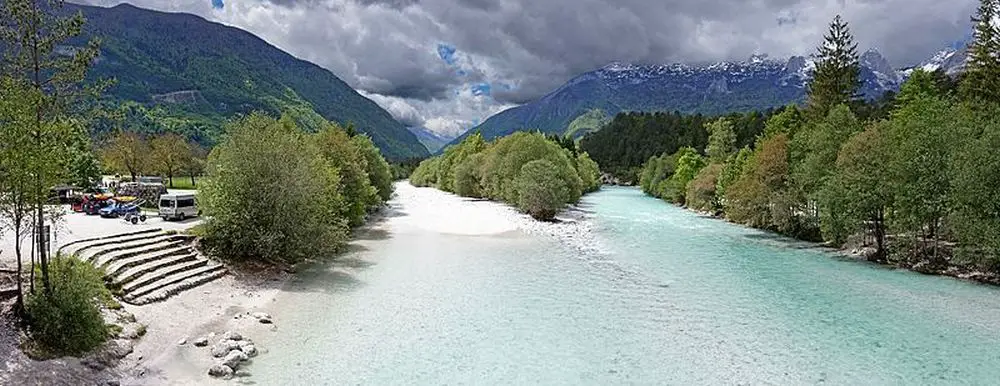
One of the Slovenia’s most scenic areas, the Soča (ITA: Isonzo) river valley, a filming location for fantasy movies like Narnia (Prince Caspian, 2008) and one of the main Slovenian tourist destinations, was also one of the bloodiest scenes of World War One. The last of these battles, the Battle of Kobarid (Caporetto), which started on today’s date, is also the one mentioned in Ernest Hemingway’s A Farewell to Arms.
Italy entered WWI due to an alliance with Germany and Austro-Hungary that it had been part of since 1882. At the start of hostilities it refused to commit troops, claiming that the alliance was defensive in nature and that Austro-Hungary was the aggressor.
In 1915 Italy changed sides after the Triple Entente (France, Russia and Great Britain) promised it parts of the Austro-Hungarian territories, in particular the Southern Tyrol, Austrian littoral (today’s Slovenia), and Dalmatian coast (today’s Croatia) after a Austro-Hungarian defeat. In April 1915, Italy declared war on Austro-Hungary and fifteen months later it declared war on Germany.
Austro-Hungarian troops, in anticipation of the Italian offensive, moved from the border with Italy to the left bank of the Soča River to await the Italian army in a terrain difficult to conquer.
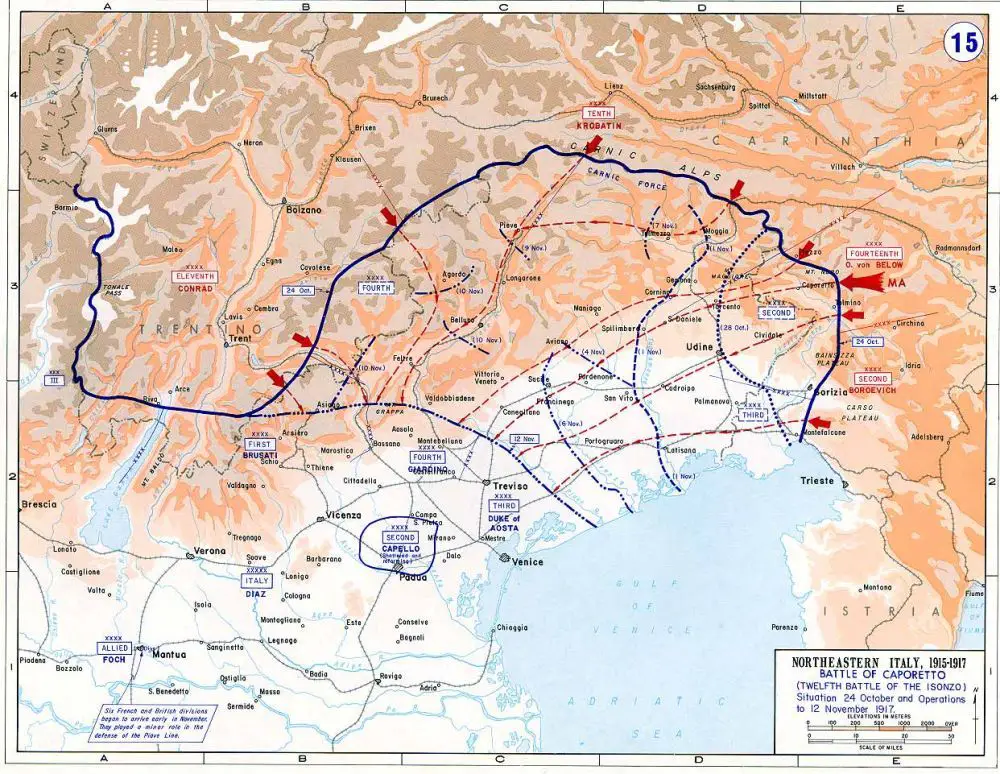
The numerically superior Italian army was led by Field Marshal Luigi Cadorna, a proponent of the frontal assault, who had planned to break into the Slovenian plateau, take Ljubljana and then threaten Vienna.
On the side of numerically weaker Austro-Hungarian army was Field Marshal Svetozar Boroević, a Serbian Croat and the only non-Austrian commander of this rank, who managed to persuade Emperor Franz Joseph that what was believed to be an indefensible part of Slovenia was is in fact worth defending, which placed him in command of Soča.
The terrain did in fact prove difficult for the Italian offensive, and the battle line practically didn’t move for the first eleven battles that took place over the following two years, exerting tremendous suffering not only on the troops but also the local population, who found themselves in the middle of the crossfire, famine and disease.
In the second half of 1917 the Austrian-Hungarian army was not only exhausted by years of war in steep mountain trenches, but also losing morale due to lack of progress and the aspirations for independence by various peoples under imperial rule. Emperor Karl I (Charles I), Franz Joseph’s successor and the Austrian commanding officer, decided to ask the Germans for help. If the Soča Front had fallen, the Austrian army would have collapsed and German offensive in the western front might fail as well. The Germans agreed and in September 1917 the plan for attack was drawn which was supposed to happen on October 22, but the date eventually changed to the 24th due to preparation delays.
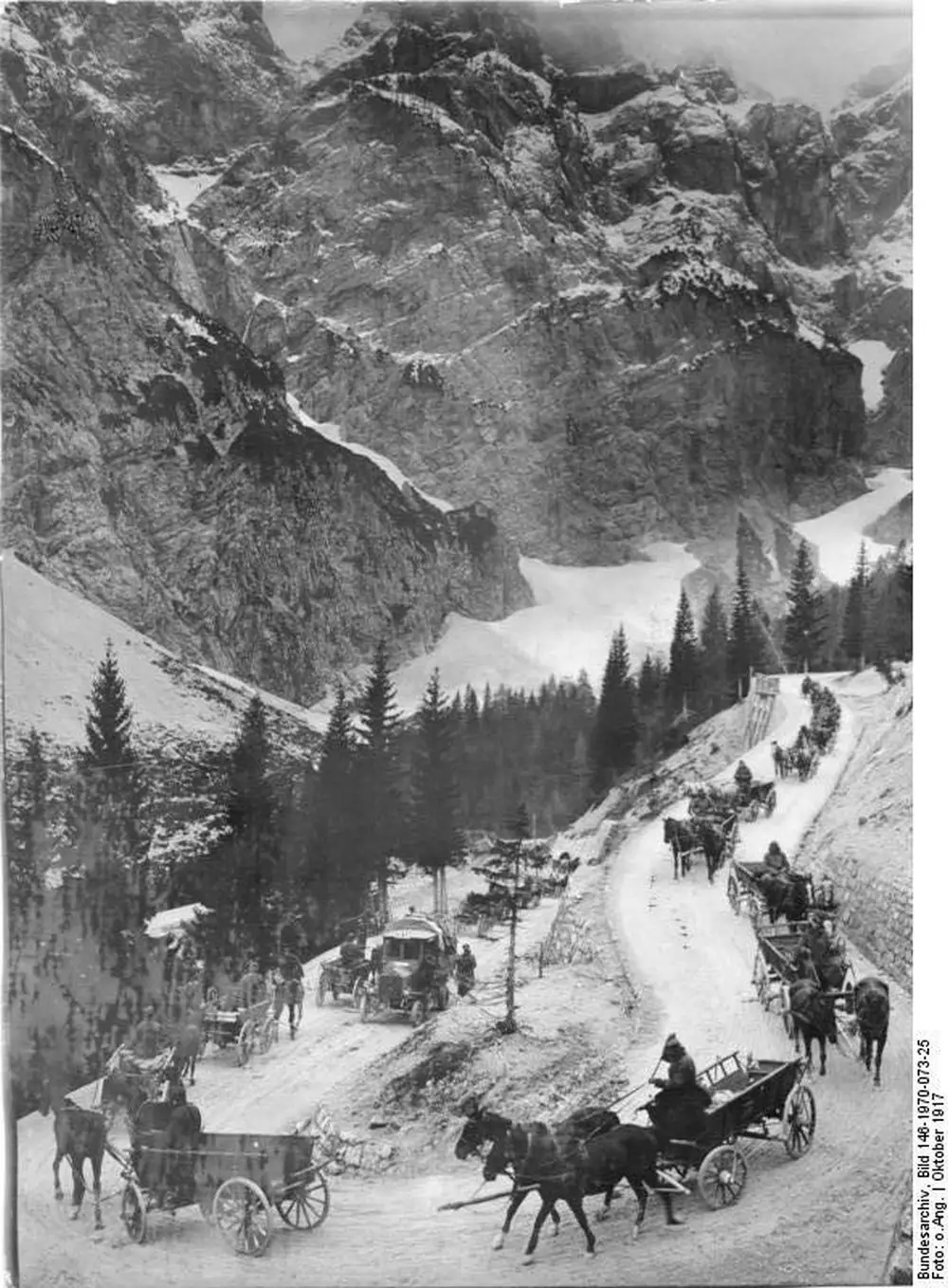
Italian commanders began suspecting that Austria was preparing an offensive on September 14th, when it the closed border with Switzerland to prevent information from being leaked. By the end of the month the Italian command headquarters were informed about the presence of the German officers in the Tolmin area and Grahovo by Bača, and then about the arrival of Germans to Ljubljana and Tolmin at the beginning of October.
Despite all the warnings that an attack would occur somewhere in the upper Soča valley, the Italian commander Cardona believed that the Austrian offensive would occur at Banjšice plato near Gorica, so he moved most of the artillery units there.
The traditional military wisdom, which Cordona had followed, dictated the preferential capture of the hills from where the surroundings could be controlled. The German and Austrian strategists turned the idea upside down, planning to attack through the valley where the enemy was most vulnerable, in order to surround the heavily fortified hills and take them down one by one in the second phase of the offensive. In realization of this plan, they got a lot of help from the weather, as on the day of the attack it rained in the valley and snowed in the mountains.
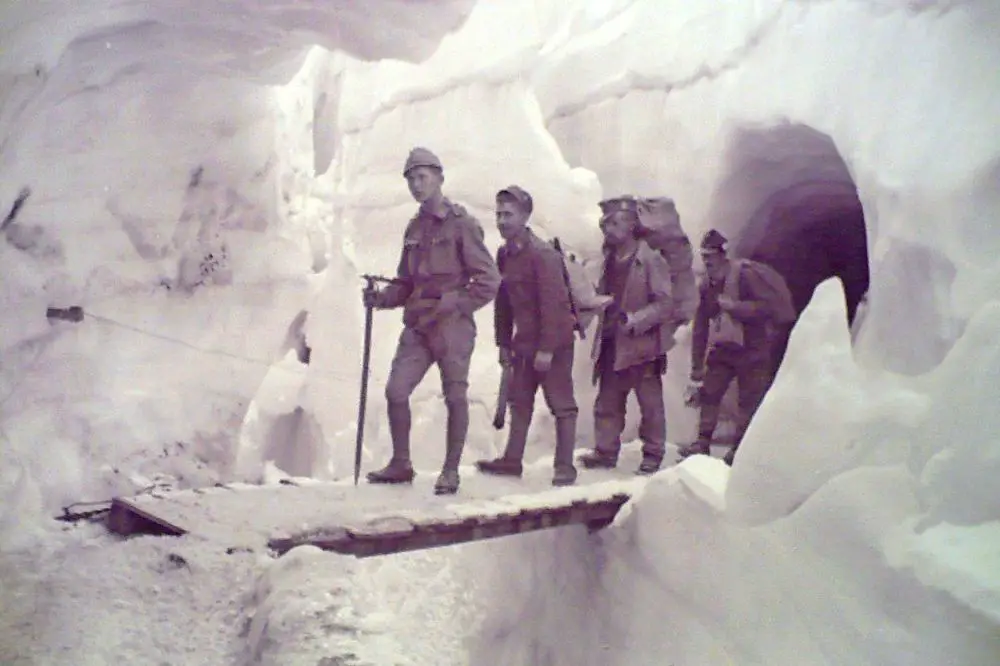
Generally speaking, the 12th battle of Soča, also known as the Battle of Kobarid or the Battle of Caporetto, is considered the first to successfully employing the vague strategy of blitzkrieg commonly believed to be a WWII invention: infantry break through the weakest link in the adversary’s defense line, getting through behind its back and finishing it with artillery after it tries to follow.
Italian defense lines were well-fortified and equipped. In fact, the positions were carved into stone walls, making them accessible from the front face only. To get to their positions, which were distributed in three parallel defense lines, one would also have to get over the wire hurdles first.
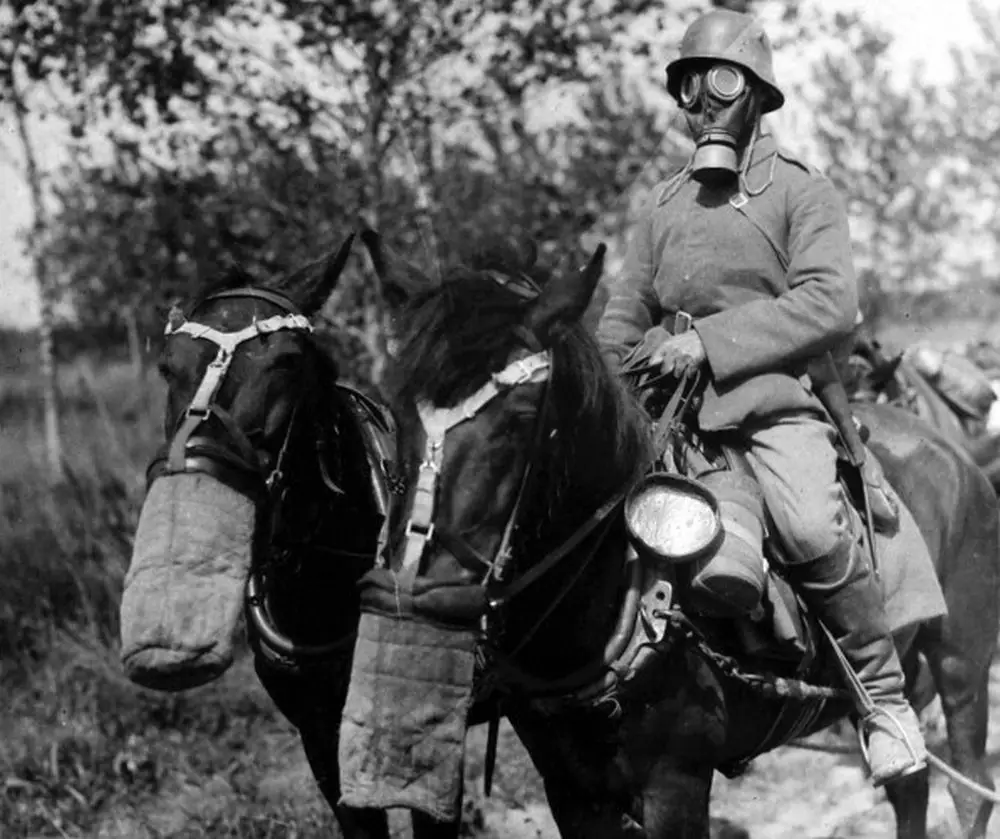
The Austro-Hungarian and German army decided to solve the problem by the use of gas, which had already been used by the Austrian army in 1916. The gas used then was chlorine. This time, two gasses were prepared to deploy, chloroarsine and phosgene, the first one being a sneezing agent which seeped through the gas mask filters and caused an irritation which would force soldiers to take their masks off and thus inhale the second gas, phosgene, the deadly poison.
The battle began at two in the morning, when more than 111,000 gas grenades, the first the ones marked with blue crosses, then the ones with green crosses, were shot at the Italian side. Then the front was quiet till six in the morning, when full fire opened at the attempts to fill in the gaps in the defense lines. The infantry then moved through the valley with almost no resistance, advancing about 25 kilometers towards Italy on the first day alone.
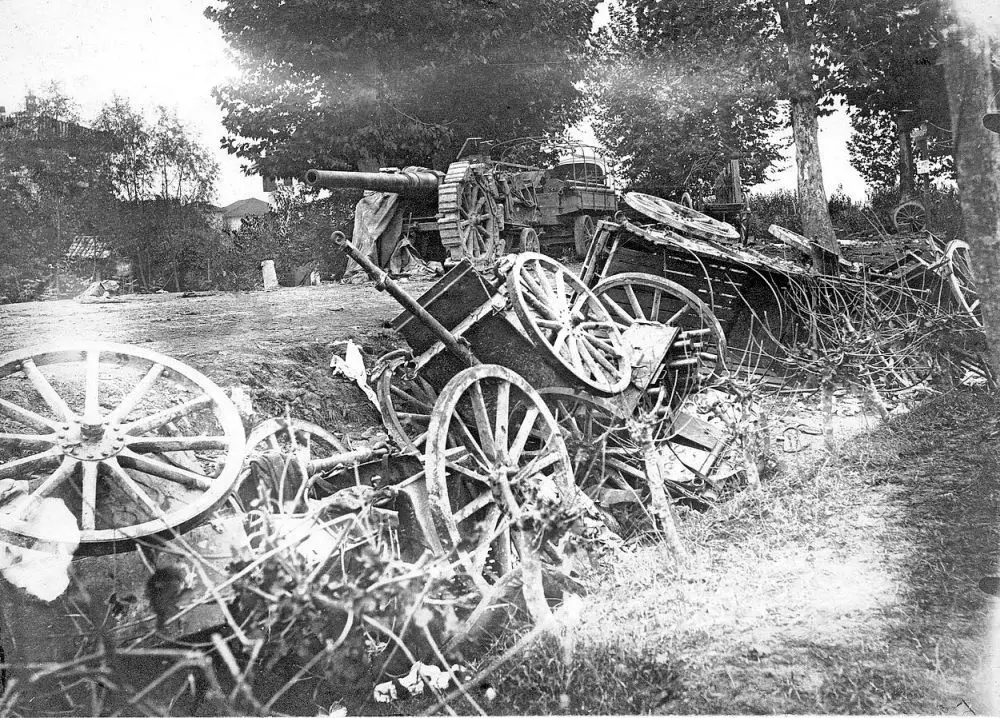
Eventually the attackers were stopped at the Piava River, where they were decisively defeated in the Battle of Vittorio Veneto in October 1918.
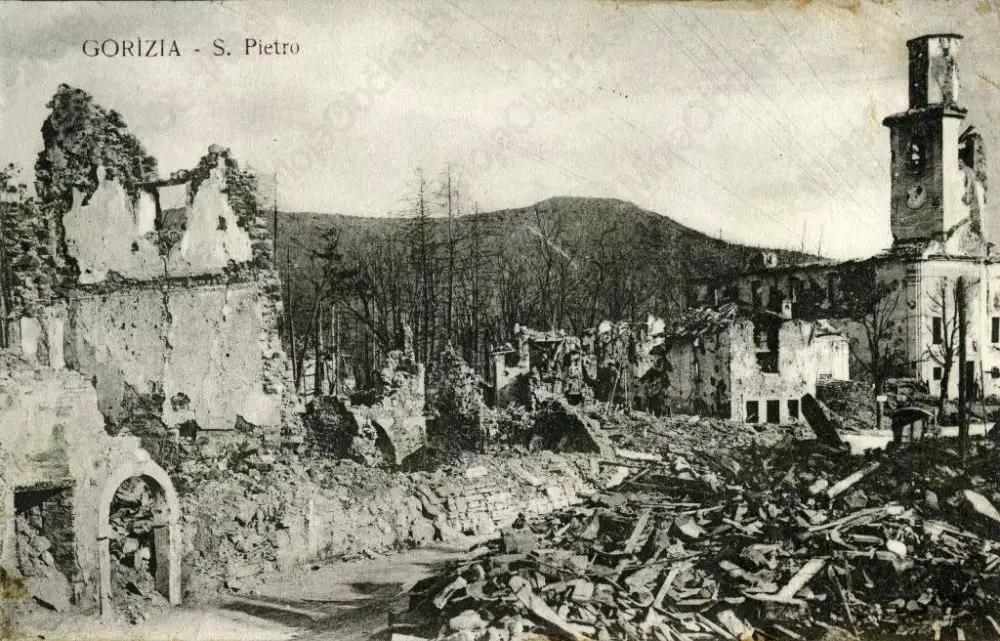
Austria-Hungary surrendered on 11 November 1918. The larger part of Carniola joined the Kingdom of Serbs, Croats and Slovenes (Kingdom of Yugoslavia), while Italy got its promised spoils of war (apart from Dalmatia) that included the former Austrian littoral with the border line drawn just under the peak of Triglav.
Halloween means another all-night movie marathon at Ljubljana’s Kinodvor, with five thrilling horror movies to enjoy from 19:00 Thursday until past sunrise on Friday. The programme, selected by Marcel Štefančič Jr., will be supported by a horror make-up service and bloody specialties in the café, and a special DVD offer in the bookshop.
Tickets for a single screening are €5.30, or €4.50 Kinodvor Club members, the over 60s, students or people in costumes. If you want to stay up all night with the film freaks then you can get a ticket to all the screenings €21, or €17 for the reduced group.
If staying up all night isn’t your thing, or you don’t live in Ljubljana, then you can still enjoy the following trailers and click here to see what’s playing at Kinodvor during regular hours this week.
Thursday 31/10/19
19:00 – The Lighthouse
21:30 – The Lodge
00:00 – Midsommar
Friday 01/11/19
02:45 – The Witch: Part 1 - The Subversion, (Korean with English subtitles)
05:15 – Piercing
For those wondering how Slovenia plans to deal with an aging society and a shortage of medical staff and care workers, a recent story in The Philippine Star may provide an answer.
The Filipino Department of Labour and Employment has announced that Slovenia is looking for from 2,000 to 5,000 skilled and semi-skilled workers to move to Europe and address labour shortages in the country. The positions that would be open to Filipinos in the deal, which has yet to be signed, are expected to include healthcare workers, nurses, engineers, truck drivers, heavy machine and equipment operators, household service and staff in other industries.
Filipino Labour Secretary Silvestre Bello III said that a technical working group still needs to negotiate the terms of the agreement and ensure the protection and safety of the workers, which would take around three months. The exact jobs and qualifications will then be announced, but the latter will certainly include proficiency in the English language.
More details can be found here.
STA, 22 October - Parliament backed on Tuesday legislative changes that raise the minimum net hourly rate for student work from EUR 4.13 to EUR 4.56. The opposition Left, which initiated the raise, had been pushing for more, but failed to get support from the coalition and remaining opposition parties, which fear businesses may have trouble handling the new rate.
After the minimum rate for student work, a flexible labour form much sought by employers, was first set only in 2015, the Left made additional regulation one of its conditions for its support to the minority government.
The party put forward its own proposal for changes to the fiscal balance act in July, proposing that the minimum gross rate be raised from EUR 4.89 to EUR 5.90.
The Left later lowered the figure to EUR 5.63, saying this was a compromise reached in negotiations with the coalition, only to see the coalition members of the Finance Committee reduce it further to EUR 5.40 or EUR 4.56 net.
Although voting in favour, coalition MPs also seemed reluctant to back the final figure in today's plenary vote, with Aljaž Kovačič of the senior coalition Marjan Šarec List (LMŠ) for instance arguing the raise - which will take effect on 1 January 2020 - could lead to more undeclared work and actually harm the students.
Soniboj Knežak of the coalition SocDems also argued more focus should be put on inspections "as opposed to measures that could destroy student work" and Mojca Žnidarič of the coalition Modern Centre Party (SMC) criticised the Left for drawing up its proposal without consulting the ministry.
The opposition National Party (SNS) party voted in favour, arguing the raise was only symbolic, New Slovenia (NSi) said it would not oppose the raise while warning the rate needed to calculated so as not to disrupt the market, while the Democrats (SDS) said they could not support it but would also not oppose it.
"For many companies, especially those outside of central Slovenia this means a substantial additional cost. It could happen that this will lead to significant decree in the amount of student work," the SDS's Suzana Lep Šimenko said.
The Left's Miha Kordiš begged to differ, arguing the competitive edge of student work lie not in the hourly rate but in its flexibility. He also called for a comprehensive plan that will make sure "no student's mere survival will depend on them accepting underpaid and indecently precarious labour".
STA, 24 October 2019 - The country's top research institution, the Jožef Stefan Institute (IJS), and the Slovenian World Congress are hosting a conference on Thursday and Friday featuring scientists and business executives from around the world. The topics to be discussed range from the impact of the global economy on society to climate change.
The conference is divided into four parts. The first will focus on the effects of the global economy on society, where Nina Pavčnik of the Dartmouth College in the US will speak about inequality in international trade today, while Mojmir Mrak of the Ljubljana Economics Faculty will present the fragmentation of the existing and the beginnings of a new economic system.
The second part of the conference on Friday will discuss technological development and the challenges of the modern economy. Gregor Cevc from the Advanced Treatments Institute in Germany will present the latest development in biotechnological therapeutics.
Mihaela Žigman from the Max-Planck-institute, also from Germany, will present her achievements.
One section of the conference will be dedicated to the presentation of the achievements of Slovenian scientists and businesses, while another will discuss the impact of climate change on the economy.
In this section, Griša Močnik of the IJS will talk about measuring the impact of absorbing aerosols on the climate.
Today's opening of the conference will be addressed by Prime Minister Marjan Šarec, who is the honorary sponsor of the event. Education, Science and Sports Minister Jernej Pikalo and Minister for Slovenians Abroad Peter Jožef Česnik will also take the stage.
More about this conference can be found here
STA, 23 October 2019 - The receiver of the company operating the Adria Airways flight school published on Wednesday a call for bids for what is a subsidiary of the German-owned Slovenian flag carrier Adria Airways, which was sent into receivership along with its flight school on 2 October.
According to the business daily Finance, the main asset of Adria Airways Flight School is a valid ATO (Approved training organisations) licence, which would enable a potential buyer to continue training candidates for pilots.
Until 25 November, receiver Blaž Poljanšek will be collecting bids for the entire company, for the leasing of two PS-28 Cruiser aircraft by Czech Sport Aircraft and for the use of the FNPT II flight simulator.
Poljanšek told Finance that several candidates had shown interest in buying the licence and that he was checking how much interest existed officially through the call for bids.
He explained that the receivership had interrupted the training of around 30 pilot candidates.
Adria Airways Flight School recorded EUR 315,000 in sales revenue in 2018, down roughly 20% on 2017. The net loss amounted to EUR 339,000 in 2018 and to EUR 171,000 in 2017.
All our stories on Adria are here




